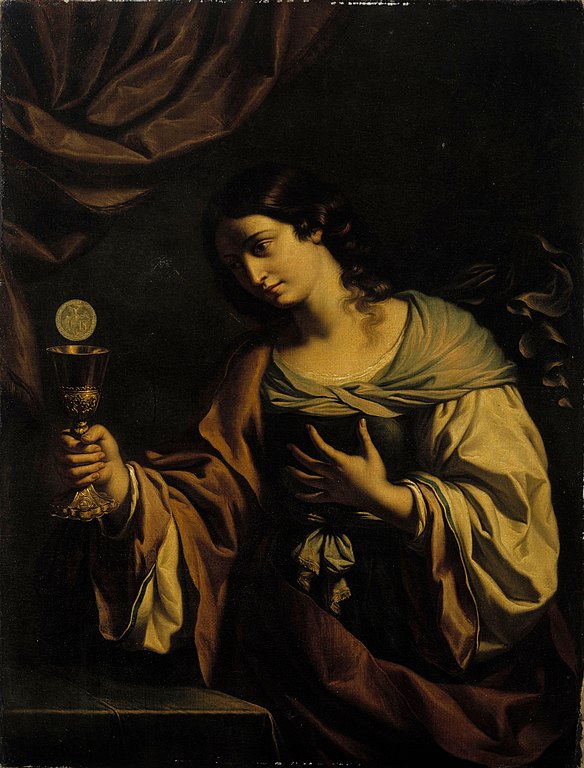 by Theresa Cavicchio
by Theresa CavicchioTo honor the August 11th feast of Saint Clare of Assisi (1194 - 1253 A.D.), we consider the life and spirituality of this first female Franciscan religious.
Although Francis and Clare grew up in the same Italian village in Umbria, they were separated by the class system entrenched there in the Middle Ages: Francis, son of the untitled merchant class; Clare, daughter of nobility.
One moving account concerning Clare’s Offreduccio family relates that during her pregnancy with Clare, her mother Ortulana was experiencing great apprehension about the impending dangers of childbirth. Praying intensely about this before the crucifix, Ortulana heard a voice reassuring her that she need not fear; the child she would bear would be a great light illuminating the whole world. In time, the name conferred on her newborn daughter was Chiara (clear), or Clare (bright one).
Despite Clare’s material advantages, numerous sources attest that even in her privileged childhood, she displayed a depth of spirituality, a closeness to God, and an inclination toward works of penance rare in one so young. She routinely shared the bounty of the family table with the poor and maintained a strong prayer life that carried over into her everyday activities.
We should not find this unusual, given the pious household in which Clare grew up, especially when considering its female members. Ilia Delio, OSF, sets the stage clearly as follows: “Clare grew up in a household of holy women, including her mother, sisters and cousins. Poverty and penance were practiced at home among the women, and Clare gained a reputation for holiness at a young age” (Clare of Assisi: A Heart Full of Love).
Managing this household was Ortulana, a pious woman who, according to The Legend of St. Clare, “ … devoted herself as much as possible to divine worship and applied herself to works of piety [and] devoutly traveled with pilgrims” to holy sites in Italy and even as far away as the Holy Land, a hazardous undertaking at the time.
In light of her spiritual grounding, it is no surprise that at age 18, Clare responded to Francis’ inspired preaching of a life given to God in strict poverty and adherence to the Gospel of Jesus. She left her family home to follow Francis’ lead, thus beginning the Order of women known as the Poor Ladies, later the Poor Clares, the Franciscan Second Order. The seeds of Clare’s vocation, long gestating, had come to full fruition.
In short order, Francis placed the fledgling Order in a small enclosure at the Church of San Damiano. Very quickly, women of all social classes found themselves drawn to the simplicity and poverty of life exemplified there by Clare and her spiritual daughters. When Ortulana and her younger daughters Catherine (renamed Agnes by Francis, later canonized in her own right) and Beatrice joined Clare, the family circle was complete once again.
Unlike Francis’ itinerant ministry, Clare’s was lived out solely in the enclosure at San Damiano, where she served as abbess -- assuming that role only in obedience to Francis -- until her death at age 59.
Soon, Clare’s dedicated life of holiness and good deeds was attested to by numerous sworn witnesses prior to her canonization, which occurred only two years after her death.
Sister Francesca, a witness during the canonization process, had lived for more than twenty-one years with Saint Clare as her Abbess. According to the Acts of the Process of Canonization, “She [Sister Francesca] said if she had as much wisdom as Solomon and as much eloquence as Saint Paul, she did not believe she could tell fully of the goodness and holiness that she saw in Lady Clare throughout all the said time.”
Corroborating Saint Clare’s sanctity during her own testimony, her biological sister Beatrice stated that Clare’s “life was, from her childhood, almost angelic … She was careful about good deeds of holiness so her good reputation was spread about among all who knew her;” even to the point of distributing her entire inheritance to the poor (Acts of the Process of Canonization).
In the humble monastery at San Damiano, Saint Clare led her Poor Ladies in a life of poverty, simplicity, service, and intense devotion to Jesus. Legendary accounts describe her mortifications, severe fasting, deep contemplative prayer, miraculous healings, and service to those committed to her care.
Given our contemporary tendencies to self-indulgence, we can find much to emulate in the legacy left to us by a woman whose holy vocation was lived out in total seclusion, in a spirit of other-centeredness, humility, and strict poverty. Saint Clare never wavered in her focus on God and others.
In closing, we do well to meditate on an excerpt from the second letter of Saint Clare to Agnes of Prague cited by Murray Bodo, OFM, in his book Clare, A Light in the Garden. It says a great deal about Saint Clare’s spirituality and deep-seated beliefs.
When you suffer with him, you will reign with him; when you grieve with him, you will rejoice with him; when with him you die on the cross of harrowing demands or bitter circumstances, you will possess a heavenly dwelling place in the splendor of the saints; your name, written in the book of life, will be glorious among all.
© All Rights Reserved, Living His Life Abundantly®/Women of Grace® http://www.womenofgrace.com
